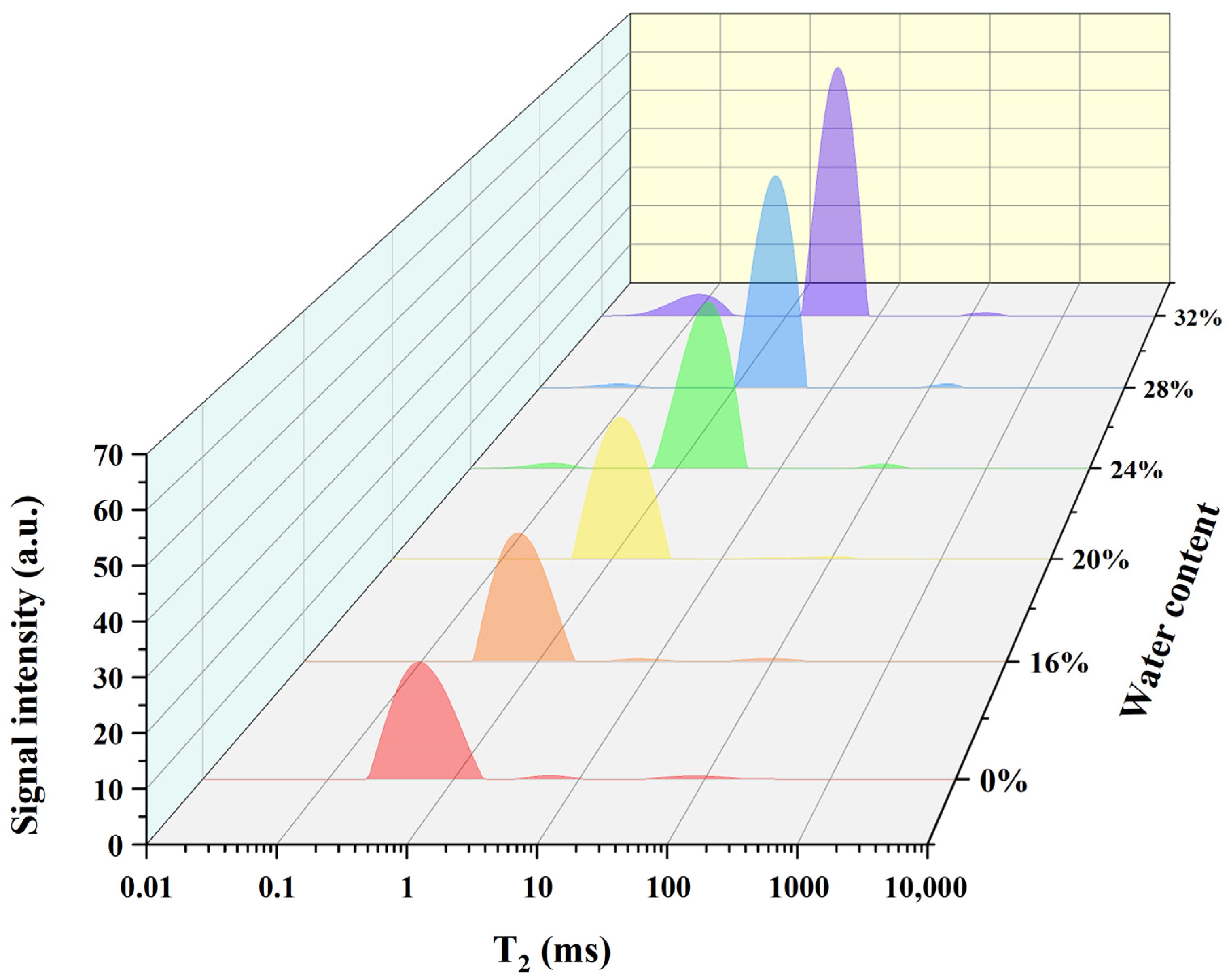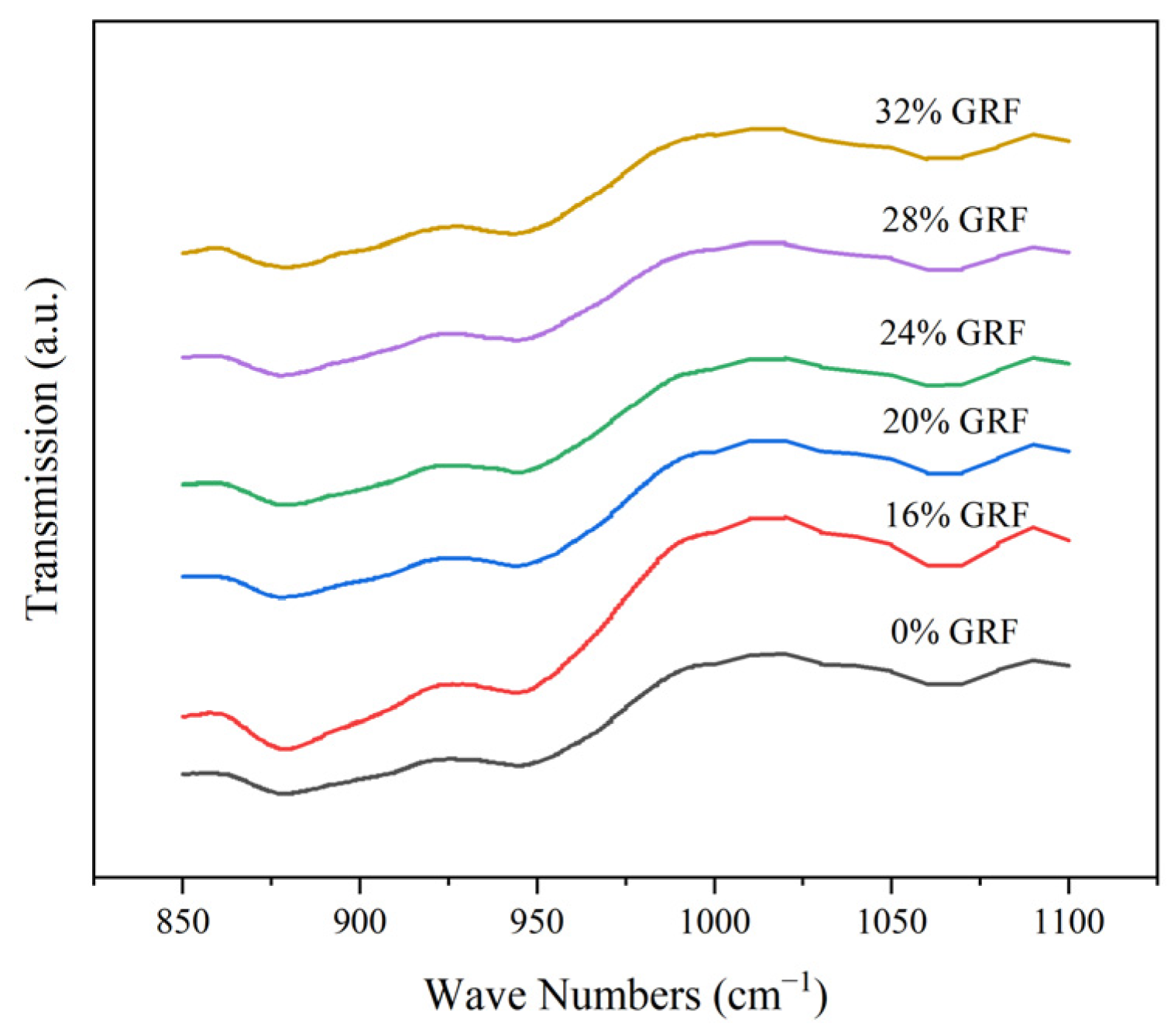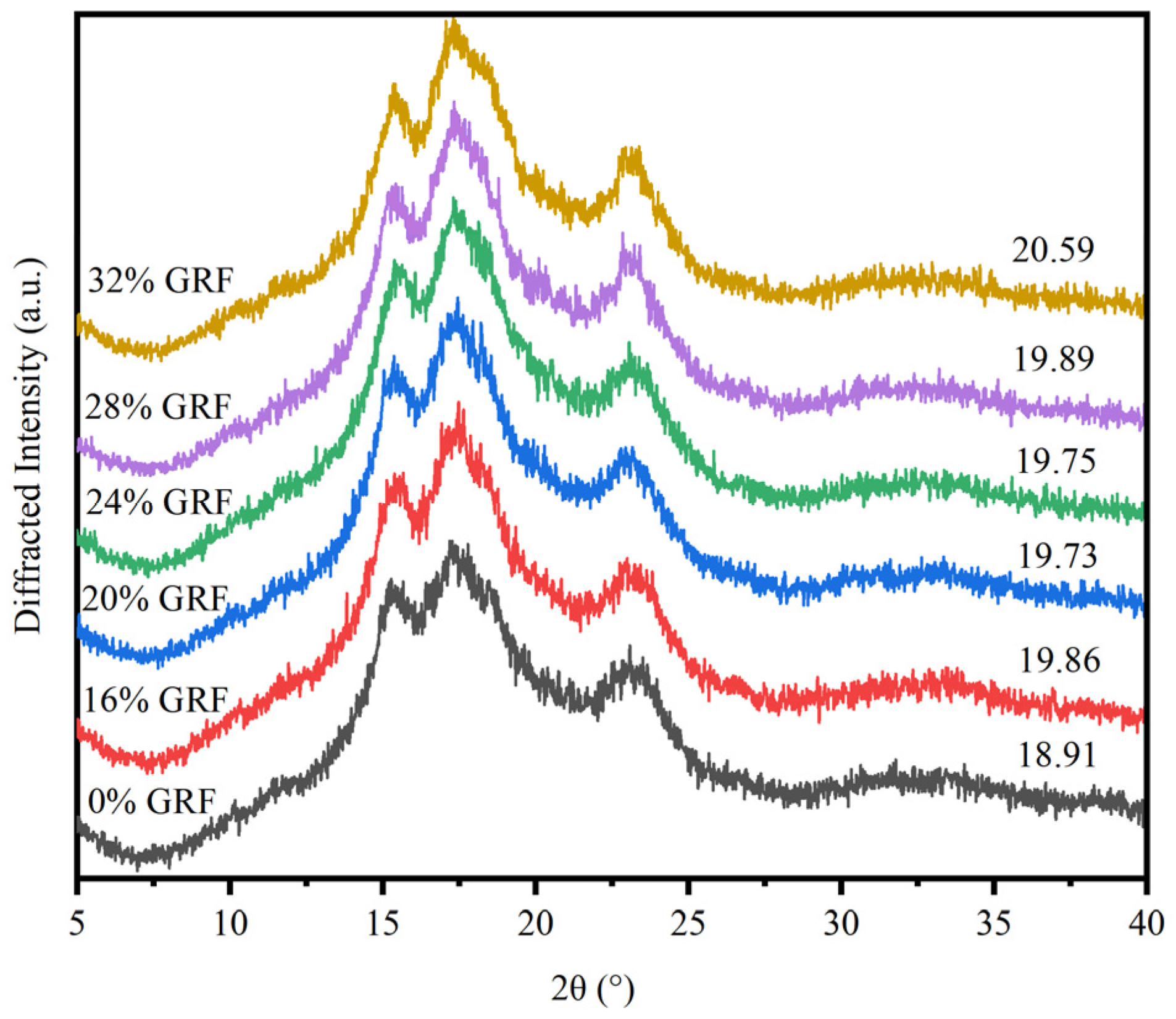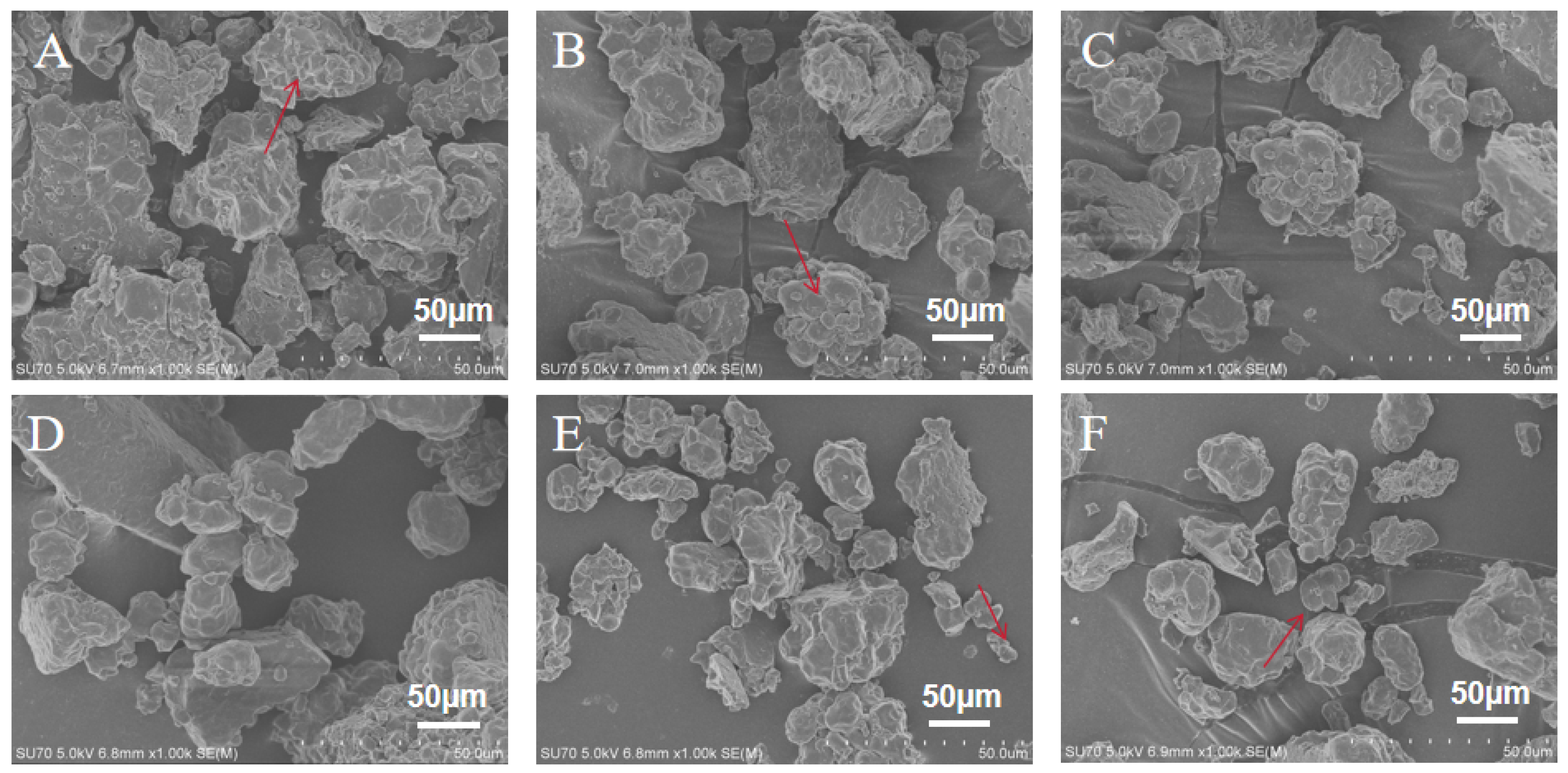Effect of Water Content in Semidry Grinding on the Quality of Glutinous Rice Flour
Abstract
:1. Introduction
2. Materials and Methods
2.1. Materials
2.2. Determination of Soaking Temperature
2.3. Ash and Fibre Analysis
2.4. Semidry Grinding
2.5. Low-Field Nuclear Magnetic Resonance (LF-NMR)
2.6. Water Hydration Properties
2.7. Particle Size
2.8. Differential Scanning Calorimetry (DSC) Analysis
2.9. Fourier Transform-Infrared Spectroscopy (FT-IR)
2.10. X-ray Diffraction (XRD)
2.11. Rheological Properties
2.12. Microstructure
2.13. Statistical Analysis
3. Results and Discussion
3.1. Analysis of the Water Status via LF-NMR
3.2. Water Hydration Properties of Glutinous Rice Flour
3.3. Particle Size Properties of Glutinous Rice Flour
3.4. Thermal Properties
3.5. FTIR Analysis
3.6. Crystalline Structure
3.7. Analysis of Rheological Properties
3.8. Scanning Electron Microscopy (SEM)
4. Conclusions
Supplementary Materials
Author Contributions
Funding
Institutional Review Board Statement
Informed Consent Statement
Data Availability Statement
Acknowledgments
Conflicts of Interest
References
- Zhang, H.; Wu, F.; Xu, D.; Xu, X. Endogenous alpha-amylase explains the different pasting and rheological properties of wet and dry milled glutinous rice flour. Food Hydrocoll. 2021, 113, 106425. [Google Scholar] [CrossRef]
- Qiu, C.; Cao, J.; Xiong, L.; Sun, Q. Differences in physicochemical, morphological, and structural properties between rice starch and rice flour modified by dry heat treatment. Starch-Stärke 2015, 67, 756–764. [Google Scholar] [CrossRef]
- Burešová, I.; Červenka, L.; Šebestíková, R.; Augustová, M.; Jarošová, A. Applicability of Flours from Pigmented and Glutinous Rice in Gluten-Free Bread Baking. Foods 2023, 12, 1324. [Google Scholar] [CrossRef]
- Zhu, L.; Cheng, L.; Zhang, H.; Wang, L.; Qian, H.; Qi, X.; Wu, G. Research on migration path and structuring role of water in rice grain during soaking. Food Hydrocoll. 2019, 92, 41–50. [Google Scholar] [CrossRef]
- Fang, S.; Chen, M.; Xu, F.; Liu, F.; Zhong, F. The Possibility of Replacing Wet-Milling with Dry-Milling in the Production of Waxy Rice Flour for the Application in Waxy Rice Ball. Foods 2023, 12, 280. [Google Scholar] [CrossRef]
- Lin, Z.; Geng, D.-H.; Qin, W.; Huang, J.; Wang, L.; Liu, L.; Tong, L.-T. Effects of damaged starch on glutinous rice flour properties and sweet dumpling qualities. Int. J. Biol. Macromol. 2021, 181, 390–397. [Google Scholar] [CrossRef]
- Lee, M.G.; Son, S.H.; Choung, M.G.; Kim, S.T.; Ko, J.M.; Han, W.Y.; Yoon, W.B. Effect of Milling Methods and Particle Size on Rice Cake (Baeksulgi) Characteristics. Food Eng. Prog. 2015, 19, 1–7. [Google Scholar] [CrossRef]
- Bu, X.; Chen, Y.; Ma, G.; Sun, Y.; Ni, C.; Xie, G. Wet and dry grinding of coal in a laboratory-scale ball mill: Particle-size distributions. Powder Technol. 2020, 359, 305–313. [Google Scholar] [CrossRef]
- Ren, M.-Y.; Tong, L.-T.; Li, X.; Xie, D.; Wang, L.; Zhou, X.; Zhong, K.; Liu, L.; Zhou, S.; Yi, C. Effects of hot air treatment on the quality attributes of semidry-milled Indica rice. J. Cereal Sci. 2018, 79, 93–97. [Google Scholar] [CrossRef]
- Sharma, P.; Chakkaravarthi, A.; Singh, V.; Subramanian, R. Grinding characteristics and batter quality of rice in different wet grinding systems. J. Food Eng. 2008, 88, 499–506. [Google Scholar] [CrossRef]
- Heo, S.; Lee, S.M.; Shim, J.-H.; Yoo, S.-H.; Lee, S. Effect of dry- and wet-milled rice flours on the quality attributes of gluten-free dough and noodles. J. Food Eng. 2013, 116, 213–217. [Google Scholar] [CrossRef]
- Tong, L.-T.; Gao, X.; Lin, L.; Liu, Y.; Zhong, K.; Liu, L.; Zhou, X.; Wang, L.; Zhou, S. Effects of semidry flour milling on the quality attributes of rice flour and rice noodles in China. J. Cereal Sci. 2015, 62, 45–49. [Google Scholar] [CrossRef]
- Lin, Z.; Huang, J.; Qin, W.; Geng, D.; Wang, L.; Zhou, X.; Liu, L.; Zhou, S.; Tong, L.-T. Effects of moisture changes on physicochemical properties of rice flour during semidry grinding. J. Cereal Sci. 2021, 100, 103254. [Google Scholar] [CrossRef]
- Kaur, R.; Prasad, K. Elucidation of chickpea hydration, effect of soaking temperature, and extent of germination on characteristics of malted flour. J. Food Sci. 2022, 87, 2197–2210. [Google Scholar] [CrossRef] [PubMed]
- Czaja, T.; Sobota, A.; Szostak, R. Quantification of Ash and Moisture in Wheat Flour by Raman Spectroscopy. Foods 2020, 9, 280. [Google Scholar] [CrossRef]
- McCleary, B.V.; Sloane, N.; Draga, A.; Lazewska, I. Measurement of Total Dietary Fiber Using AOAC Method 2009.01 (AACC International Approved Method 32-45.01): Evaluation and Updates. Cereal Chem. 2013, 90, 396–414. [Google Scholar] [CrossRef]
- Shi, C.; Zhu, S.; Ding, G.; Du, C.; Huang, D.; Li, Y. Modulating Structure and Properties of Glutinous Rice Flour and Its Dumpling Products by Annealing. Processes 2021, 9, 2248. [Google Scholar] [CrossRef]
- Wang, G.; Yan, X.; Wang, B.; Hu, X.; Chen, X.; Ding, W. Effects of milling methods on the properties of rice flour and steamed rice cakes. LWT 2022, 167, 113848. [Google Scholar] [CrossRef]
- Wang, H.; Xiao, N.; Wang, X.; Zhao, X.; Zhang, H. Effect of pregelatinized starch on the characteristics, microstructures, and quality attributes of glutinous rice flour and dumplings. Food Chem. 2019, 283, 248–256. [Google Scholar] [CrossRef]
- Zhai, Y.; Zhang, H.; Xing, J.; Sang, S.; Zhan, X.; Liu, Y.; Jia, L.; Li, J.; Luo, X. Long-Term Retrogradation Properties and In Vitro Digestibility of Waxy Rice Starch Modified with Pectin. Foods 2023, 12, 3981. [Google Scholar] [CrossRef]
- Wang, H.; Liu, Y.; Chen, L.; Li, X.; Wang, J.; Xie, F. Insights into the multi-scale structure and digestibility of heat-moisture treated rice starch. Food Chem. 2018, 242, 323–329. [Google Scholar] [CrossRef] [PubMed]
- Pan, L.; Xing, J.; Luo, X.; Li, Y.; Sun, D.; Zhai, Y.; Yang, K.; Chen, Z. Influence of Electron Beam Irradiation on the Moisture and Properties of Freshly Harvested and Sun-Dried Rice. Foods 2020, 9, 1139. [Google Scholar] [CrossRef]
- Liu, W.; Zhang, M.; Bhandari, B.; Yu, D. A novel combination of LF-NMR and NIR to intelligent control in pulse-spouted microwave freeze drying of blueberry. Lwt-Food Sci. Technol. 2021, 137, 110455. [Google Scholar] [CrossRef]
- Chen, L.; Tian, Y.; Tong, Q.; Zhang, Z.; Jin, Z. Effect of pullulan on the water distribution, microstructure and textural properties of rice starch gels during cold storage. Food Chem. 2017, 214, 702–709. [Google Scholar] [CrossRef]
- Zhou, X.; Liu, L.; Fu, P.; Lyu, F.; Zhang, J.; Gu, S.; Ding, Y. Effects of infrared radiation drying and heat pump drying combined with tempering on the quality of long-grain paddy rice. Int. J. Food Sci. Technol. 2018, 53, 2448–2456. [Google Scholar] [CrossRef]
- Wu, Y.; Fan, D.; Gao, Y.; Ma, S.; Yan, B.; Lian, H.; Zhao, J.; Zhang, H. Study on water proton distribution and flow status of starch during the hydration process. Int. J. Biol. Macromol. 2018, 118, 997–1003. [Google Scholar] [CrossRef]
- Amagliani, L.; O’Regan, J.; Kelly, A.L.; O’Mahony, J.A. Chemistry, structure, functionality and applications of rice starch. J. Cereal Sci. 2016, 70, 291–300. [Google Scholar] [CrossRef]
- Dhital, S.; Shrestha, A.K.; Gidley, M.J. Effect of cryo-milling on starches: Functionality and digestibility. Food Hydrocoll. 2010, 24, 152–163. [Google Scholar] [CrossRef]
- Hasjim, J.; Li, E.; Dhital, S. Milling of rice grains: The roles of starch structures in the solubility and swelling properties of rice flour. Starch-Stärke 2012, 64, 631–645. [Google Scholar] [CrossRef]
- Desam, G.P.; Li, J.; Chen, G.; Campanella, O.; Narsimhan, G. A mechanistic model for swelling kinetics of waxy maize starch suspension. J. Food Eng. 2018, 222, 237–249. [Google Scholar] [CrossRef]
- Yu, J.; Wang, S.; Wang, J.; Li, C.; Xin, Q.; Huang, W.; Zhang, Y.; He, Z.; Wang, S. Effect of laboratory milling on properties of starches isolated from different flour millstreams of hard and soft wheat. Food Chem. 2015, 172, 504–514. [Google Scholar] [CrossRef] [PubMed]
- Shi, L.; Li, W.; Sun, J.; Qiu, Y.; Wei, X.; Luan, G.; Hu, Y.; Tatsumi, E. Grinding of maize: The effects of fine grinding on compositional, functional and physicochemical properties of maize flour. J. Cereal Sci. 2016, 68, 25–30. [Google Scholar] [CrossRef]
- Wu, T.; Wang, L.; Li, Y.; Qian, H.; Liu, L.; Tong, L.; Zhou, X.; Wang, L.; Zhou, S. Effect of milling methods on the properties of rice flour and gluten-free rice bread. LWT 2019, 108, 137–144. [Google Scholar] [CrossRef]
- Wang, Q.; Li, L.; Zheng, X. A review of milling damaged starch: Generation, measurement, functionality and its effect on starch-based food systems. Food Chem. 2020, 315, 126267. [Google Scholar] [CrossRef] [PubMed]
- Sun, Y.; Wu, Z.; Hu, B.; Wang, W.; Ye, H.; Sun, Y.; Wang, X.; Zeng, X. A new method for determining the relative crystallinity of chickpea starch by Fourier-transform infrared spectroscopy. Carbohydr. Polym. 2014, 108, 153–158. [Google Scholar] [CrossRef]
- Li, W.; Zhang, W.; Gong, S.; Gu, X.; Yu, Y.; Wu, J.; Wang, Z. Low and high methoxyl pectin lowers on structural change and digestibility of fried potato starch. LWT 2020, 132, 109853. [Google Scholar] [CrossRef]
- Asmeda, R.; Noorlaila, A.; Norziah, M.H. Relationships of damaged starch granules and particle size distribution with pasting and thermal profiles of milled MR263 rice flour. Food Chem. 2016, 191, 45–51. [Google Scholar] [CrossRef]
- Zhai, Y.; Xing, J.; Luo, X.; Zhang, H.; Yang, K.; Shao, X.; Chen, K.; Li, Y. Effects of Pectin on the Physicochemical Properties and Freeze-Thaw Stability of Waxy Rice Starch. Foods 2021, 10, 2419. [Google Scholar] [CrossRef]
- Li, Z.; Wang, L.; Chen, Z.; Yu, Q.; Feng, W. Impact of protein content on processing and texture properties of waxy rice flour and glutinous dumpling. J. Cereal Sci. 2018, 81, 30–36. [Google Scholar] [CrossRef]






| Temperature (°C) | Water Content (%) | WAI | WS | SP |
|---|---|---|---|---|
| 25 | 0 | 4.49 ± 0.03 c | 5.67 ± 0.47 a | 4.72 ± 0.30 c |
| 16 | 4.51 ± 0.36 c | 4.90 ± 0.40 b | 4.78 ± 0.39 bc | |
| 20 | 4.89 ± 0.02 ab | 4.03 ± 0.23 c | 5.09 ± 0.03 ab | |
| 24 | 5.11 ± 0.04 a | 3.43 ± 0.23 d | 5.30 ± 0.06 a | |
| 28 | 4.77 ± 0.06 bc | 2.77 ± 0.27 e | 4.90 ± 0.05 bc | |
| 32 | 4.58 ± 0.04 bc | 2.20 ± 0.10 e | 4.68 ± 0.03 c | |
| 100 | 0 | 15.30 ± 0.00 a | 36.20 ± 1.70 a | 23.95 ± 0.63 a |
| 16 | 13.10 ± 0.20 b | 27.90 ± 0.90 b | 18.19 ± 0.23 b | |
| 20 | 12.78 ± 0.45 bc | 13.77 ± 0.57 e | 14.82 ± 0.46 d | |
| 24 | 12.37 ± 0.17 c | 25.90 ± 0.70 c | 16.69 ± 0.32 c | |
| 28 | 10.70 ± 0.60 d | 12.87 ± 0.43 e | 12.27 ± 0.72 e | |
| 32 | 12.50 ± 0.58 bc | 20.43 ± 0.93 d | 15.71 ± 0.54 d |
| Water Content (%) | ΔH (J/g) | Tp (°C) | To (°C) | Te (°C) | Particle Size (μm) |
|---|---|---|---|---|---|
| 0 | 3.113 ± 0.017 d | 66.95 ± 0.25 bc | 60.16 ± 0.22 a | 77.74 ± 0.71 d | 16.88 ± 0.28 a |
| 16 | 3.639 ± 0.042 bc | 67.17 ± 0.26 ab | 59.98 ± 1.09 a | 78.61 ± 0.28 cd | 16.08 ± 0.30 b |
| 20 | 3.555 ± 0.002 c | 67.65 ± 0.24 a | 58.58 ± 0.45 b | 80.54 ± 0.97 a | 13.58 ± 0.25 c |
| 24 | 3.594 ± 0.024 c | 67.01 ± 0.48 bc | 57.93 ± 1.13 b | 80.05 ± 0.60 ab | 13.42 ± 0.25 c |
| 28 | 3.715 ± 0.078 b | 66.73 ± 0.10 bc | 56.81 ± 0.92 c | 79.93 ± 0.86 ab | 12.56 ± 0.26 d |
| 32 | 3.945 ± 0.126 a | 66.58 ± 0.29 c | 56.85 ± 0.26 c | 79.05 ± 0.63 bc | 11.45 ± 0.25 e |
| Water Content (%) | R1047/1022 | 995 cm−1 |
|---|---|---|
| 0 | 1.020 ± 0.003 d | 0.123 ± 0.007 d |
| 16 | 1.031 ± 0.002 c | 0.232 ± 0.002 c |
| 20 | 1.033 ± 0.003 c | 0.260 ± 0.004 b |
| 24 | 1.038 ± 0.008 b | 0.265 ± 0.004 ab |
| 28 | 1.041 ± 0.002 ab | 0.270 ± 0.002 ab |
| 32 | 1.045 ± 0.003 a | 0.276 ± 0.007 a |
Disclaimer/Publisher’s Note: The statements, opinions and data contained in all publications are solely those of the individual author(s) and contributor(s) and not of MDPI and/or the editor(s). MDPI and/or the editor(s) disclaim responsibility for any injury to people or property resulting from any ideas, methods, instructions or products referred to in the content. |
© 2024 by the authors. Licensee MDPI, Basel, Switzerland. This article is an open access article distributed under the terms and conditions of the Creative Commons Attribution (CC BY) license (https://creativecommons.org/licenses/by/4.0/).
Share and Cite
Huang, T.; Ouyang, D.; Sang, S.; Li, C.; Wang, X.; Wang, X.; Xing, J.; Luo, X. Effect of Water Content in Semidry Grinding on the Quality of Glutinous Rice Flour. Foods 2024, 13, 3216. https://doi.org/10.3390/foods13203216
Huang T, Ouyang D, Sang S, Li C, Wang X, Wang X, Xing J, Luo X. Effect of Water Content in Semidry Grinding on the Quality of Glutinous Rice Flour. Foods. 2024; 13(20):3216. https://doi.org/10.3390/foods13203216
Chicago/Turabian StyleHuang, Tao, Dan Ouyang, Shangyuan Sang, Caiming Li, Xiaosan Wang, Xiao Wang, Jiali Xing, and Xiaohu Luo. 2024. "Effect of Water Content in Semidry Grinding on the Quality of Glutinous Rice Flour" Foods 13, no. 20: 3216. https://doi.org/10.3390/foods13203216







